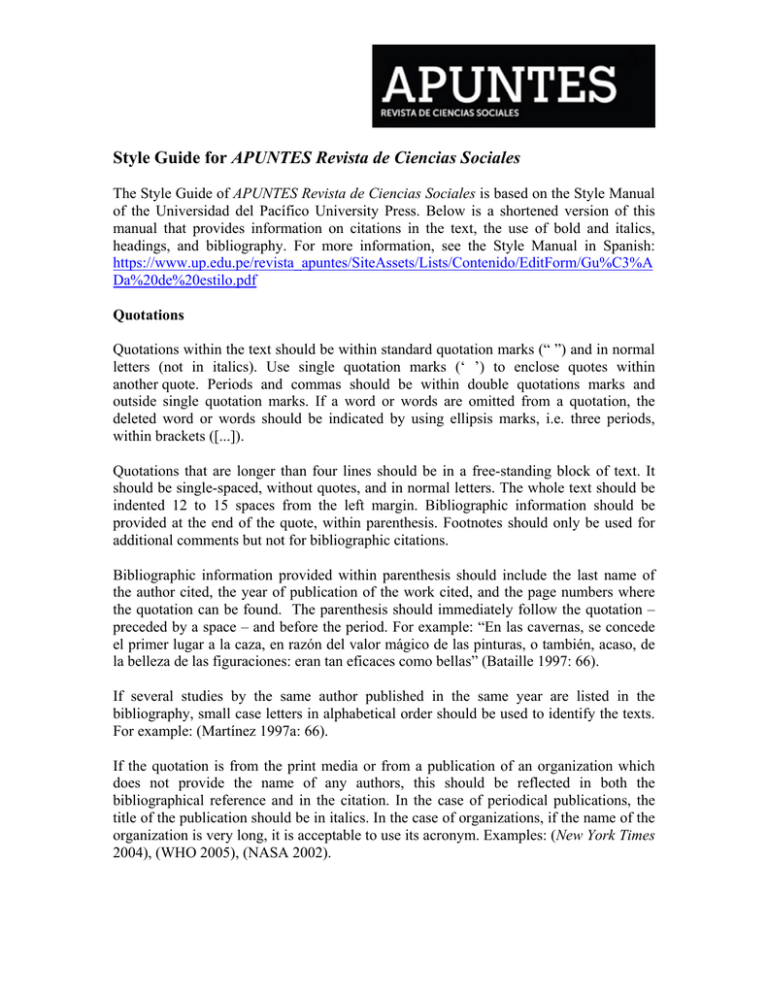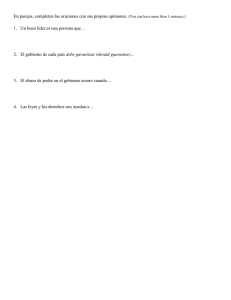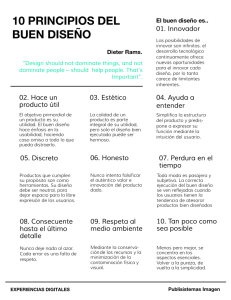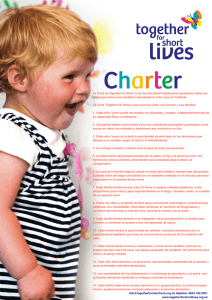Style Guide for APUNTES Revista de Ciencias Sociales
Anuncio

Style Guide for APUNTES Revista de Ciencias Sociales The Style Guide of APUNTES Revista de Ciencias Sociales is based on the Style Manual of the Universidad del Pacífico University Press. Below is a shortened version of this manual that provides information on citations in the text, the use of bold and italics, headings, and bibliography. For more information, see the Style Manual in Spanish: https://www.up.edu.pe/revista_apuntes/SiteAssets/Lists/Contenido/EditForm/Gu%C3%A Da%20de%20estilo.pdf Quotations Quotations within the text should be within standard quotation marks (“ ”) and in normal letters (not in italics). Use single quotation marks (‘ ’) to enclose quotes within another quote. Periods and commas should be within double quotations marks and outside single quotation marks. If a word or words are omitted from a quotation, the deleted word or words should be indicated by using ellipsis marks, i.e. three periods, within brackets ([...]). Quotations that are longer than four lines should be in a free-standing block of text. It should be single-spaced, without quotes, and in normal letters. The whole text should be indented 12 to 15 spaces from the left margin. Bibliographic information should be provided at the end of the quote, within parenthesis. Footnotes should only be used for additional comments but not for bibliographic citations. Bibliographic information provided within parenthesis should include the last name of the author cited, the year of publication of the work cited, and the page numbers where the quotation can be found. The parenthesis should immediately follow the quotation – preceded by a space – and before the period. For example: “En las cavernas, se concede el primer lugar a la caza, en razón del valor mágico de las pinturas, o también, acaso, de la belleza de las figuraciones: eran tan eficaces como bellas” (Bataille 1997: 66). If several studies by the same author published in the same year are listed in the bibliography, small case letters in alphabetical order should be used to identify the texts. For example: (Martínez 1997a: 66). If the quotation is from the print media or from a publication of an organization which does not provide the name of any authors, this should be reflected in both the bibliographical reference and in the citation. In the case of periodical publications, the title of the publication should be in italics. In the case of organizations, if the name of the organization is very long, it is acceptable to use its acronym. Examples: (New York Times 2004), (WHO 2005), (NASA 2002). When the quotation is from a book with two authors, both their names should appear in the citation separated by “and”. If there are more than two authors, only the first should be named followed by “et al.” In the bibliography, all authors of the work must be listed. The use of font styles within the text Bold letters should be used to emphasize terms within the text. Such emphasis is not obligatory and depends on the author’s personal style. Words in foreign languages should be in italics. Headings Headings and subheadings should always be in normal letters (and never in italics) and without periods at the end. Only the first letter of each heading should be capitalized – unless a proper name is included, in which case the first letter of the name should also be capitalized. Bibliography The bibliography should be located at the end of the article and should include all bibliographic and audiovisual sources consulted by the author(s), particularly all those cited or mentioned in the article. The most common types of citations are provided below and should be followed in every article submitted. Books with one author BURENIUS, Charlotte 2001 Testimonio de un fracaso: Huando. Habla el sindicalista Zózimo Torres. Lima: IEP. Two or more books by the same author VARGAS LLOSA, Mario 1997 Los cuadernos de don Rigoberto. Madrid: Alfaguara. 1993 El pez en el agua. Memorias. Barcelona: Seix Barral. 1977 La tía Julia y el escribidor. Lima: Peisa. Two or more books by the same author published during the same year BATAILLE, Georges 1997a El erotismo. Barcelona: Tusquets. 1997b Las lágrimas de Eros. Trad. David Fernández. Barcelona: Tusquets. Books by two or more authors PORTOCARRERO, Gonzalo; Cecilia RIVERA and Carla SAGÁSTEGUI 2005 Arguedas y el Perú de hoy. Lima: Casa de Estudios del Socialismo. Articles or chapter within books written by the same author RODRÍGUEZ REA, Miguel Ángel 1996 “Del ritual de la crítica.” In: Tras las huellas de un crítico. Lima: PUCP, pp. 23-24. Articles or chapters within a book edited by another author VARGAS ANDRÉ, Eduardo 2002 “Fases y actitudes del método.” In: RAIANO, Juana Mabel (ed.). Método de estudio para la comprensión y el aprendizaje significativo. San Juan: Papiro, pp. 69-92. Books in foreign languages: spelling and accents in each language should be respected PISKORSKI, Jan M. 2013. Miasta Księstwa Szczecińskiego do połowy XIV wieku. Poznań: Poznańskie Towarzystwo Przyjaciół Nauk. Articles in journals VALENCIA, Leonardo 2004 “Ishiguro, el destructor de su propia obra.” In: Férnix, year 3, N° 4, pp. 40-55. Articles or columns in newspapers DELGADO, Úrsula 2006 “Consuma más fruta.” In: Perú 21. December 16. Electronic publications and articles on the Internet CAMP, Craig 2006 “Kissing the Frogs.” In: The eGullet Society for Culinary Arts and Letters. November 6, 2006. Retrieved: Day/Month/Year. http://forums.egullet.org/index.php?act=home Unpublished academic thesis BOYLE, Anthony 1983 “The Epistemological Evolution of Renaissance Utopian Literature, 15161657.” Doctoral thesis. New York University.


